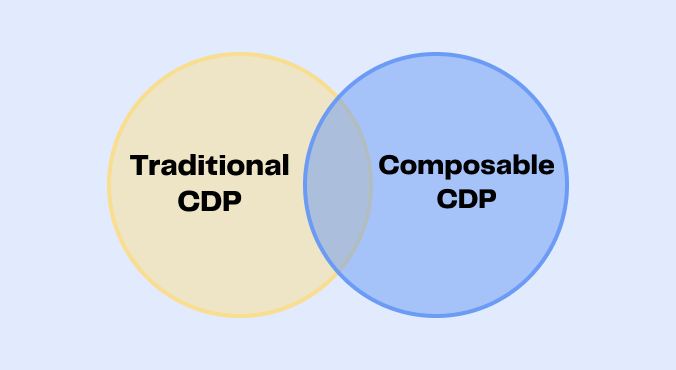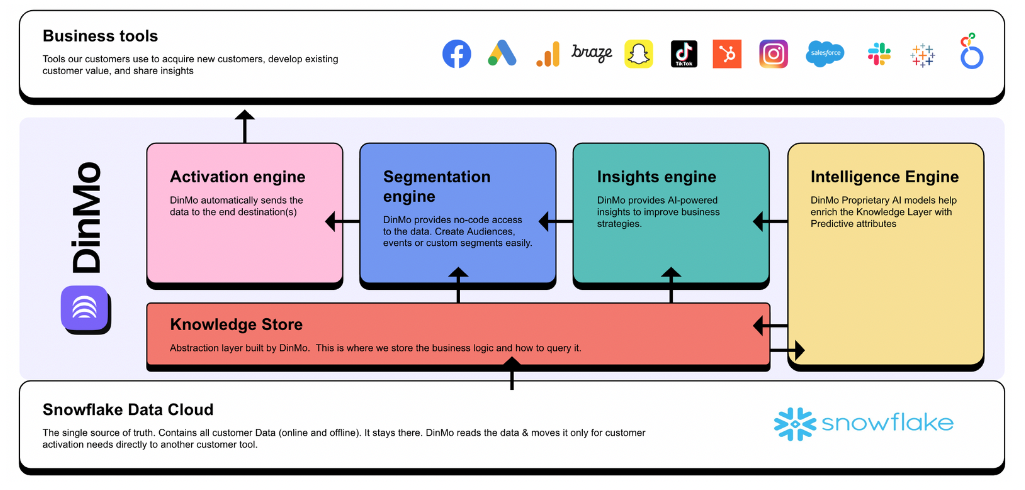If you want to create personalised marketing that really speaks to your customers, you need to have a good handle on their data. Customer Data Platforms also known as CDPs have been developed to support data-driven Marketing.
However, with the growing complexity of customer journeys and the evolution of technology, CDPs have shown many limitations, especially with the rise of the Modern Data Stack.
That's where Modular or Composable CDPs come in - they're designed to be more flexible and adaptable to today’s marketing use cases and technical stacks.
Key takeaways:
A modular CDP is a flexible customer data platform built on the company’s data warehouse.
It enables fast, compliant unification, segmentation, and activation of customer data.
Unlike traditional CDPs, it integrates seamlessly with your existing stack and adapts to your business needs.
The modular approach lays the foundation for an effective data strategy. Thanks to a modern architecture, it provides greater flexibility, scalability, and interoperability.
👉 This article discusses the history of CDPs, their limitations, and how modular CDPs became the best solution for modern marketers.
Brief History of CDPs
CDPs have been around for quite some time, but they have evolved significantly over the years. In the early days, businesses used Customer Relationship Management (CRM) systems to store customer data.
1. CRMs
CRMs are designed for managing companies’ relationships and interactions with customers and potential customers. They help companies stay connected to customers and streamline processes. CDPs and CRM tools both collect customer data, but the way they do it and the benefits they offer differ considerably.
2. DMPs
In the early 2000s, companies began using Data Management Platforms (DMPs) to collect customer data for online ads. These platforms mainly relied on third-party cookies to gain insights into unknown audiences. However, they were not effective at managing known data or storing data for extended periods of time.
Although DMPs were designed to work with other marketing technology platforms, they were typically managed by the IT department and did not provide marketers with the ability to make informed, data-driven decisions that put the customer at the center of their marketing strategy.
3. The emergence of CDPs
To keep up with the rise of digital channels in the customer journey, traditional marketing tools have tried to morph into both a data layer and a cross-channel marketing platform. CDPs were created to collect and organise customer data from multiple sources (website, mobile apps, social media, etc.) into a unified customer data base.
CDPs are used to collect, centralise, manage and activate customer data.
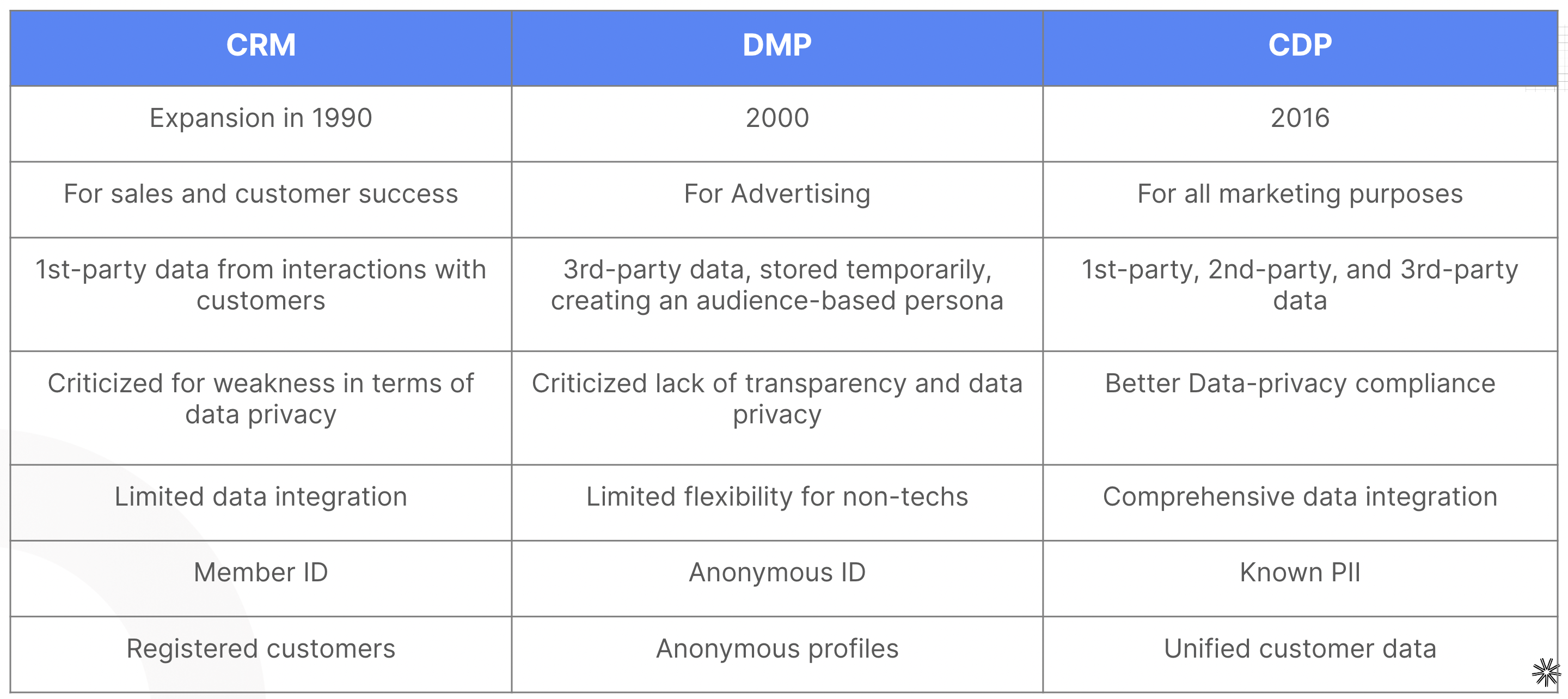
CRM vs CDP vs DMP
To guide you in your choice, articles detailing the other differences between these different tools are available on our blog:
CDP vs CEP (Customer Engagement Platform)
Packaged CDPs: Why they're not living up to expectations?
Well, while they were created to solve the problem of data fragmentation, they ended up creating some new challenges for businesses:
1. Implementation complexity
Traditional CDPs were often complex and required a lot of IT resources to implement. This meant that marketers had to rely on their IT teams to get access to customer data, which is another failed promise to marketers’ autonomy aspirations besides being a time-consuming process.
2. Not scalable or modular
Additionally, classic CDPs lacked flexibility and features to integrate with other marketing technologies, making them difficult to scale and modular.
3. Important run cost
Existing CDP license range from £100k to several million. Many companies found that they had to hire new extra skills and resources to use and maintain the platform, which led to high run costs.
4. Raising privacy issues
One of the biggest concerns with classic CDPs is the issue of privacy. Companies had to duplicate their customer data in 3rd party tools, which raised many privacy issues and may not have been compliant with standards.
5. Unfulfilled promise
Another problem is that trad CDPs often fail to answer more elaborate marketing use cases. For example, they may not be able to identify churn-risk customers or top users during a specific month. This is because classic CDPs struggle to fulfill promises like real-time data activation and a single customer view.
As a result, only 10% of CDP owners today feel that the product meets all their needs. The ideal of a 360° view of customers remains elusive…
The future in the warehouse: A Modular CDP
The demand for customer data is on the rise, but traditional Customer Data Platforms are struggling to keep up as third party cookies crumble. Fortunately, cloud data warehouses have provided a solution that serves up first-party data on a silver platter.
Enter the modular, or composable, CDP - a new type of solution built on a microservices architecture that's much more flexible and high-performing than traditional CDPs. With the ability to activate data directly from the cloud data warehouse, organisations can unlock the full potential of their data investments.
Thanks to the rise of the modern data stack, a new era of customer data management has emerged. Data teams now have the ability to create and manage their data layer on their own infrastructure, which has helped bridge the gap between data teams and marketing teams.
Modular CDP: A new customer data management system that enables organisations to access and activate data across multiple sources directly from their cloud Data Warehouses, to drive personalised marketing campaigns and enhance customer experiences.
But that's not all - the Composable CDP takes it a step further by empowering businesses to seamlessly integrate with all the marketing technologies in the menu, including CRMs, Ads, and Marketing Automation platforms. This piece of the process is called Data Activation and it is possible thanks to Reverse ETL engines (like the one offered by DinMo). This way you make sure that valuable data can be accessed and utilised across the entire marketing stack, regardless of which downstream tools are in use.
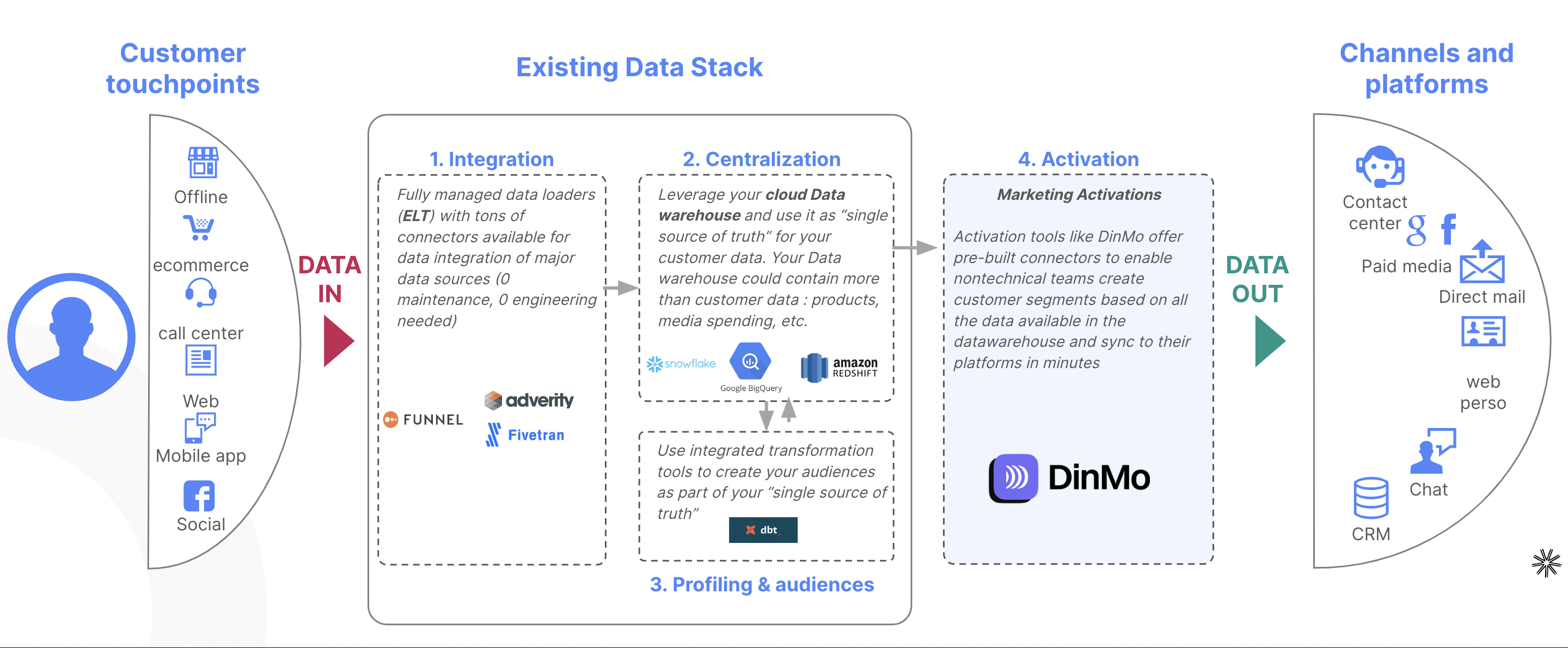
How you can leverage DinMo to transform your Existing Modern Data Stack into a Modular CDP
If you want to understand all the differences between Traditional and Composable CDPs, check our 2-pages guide below 👇
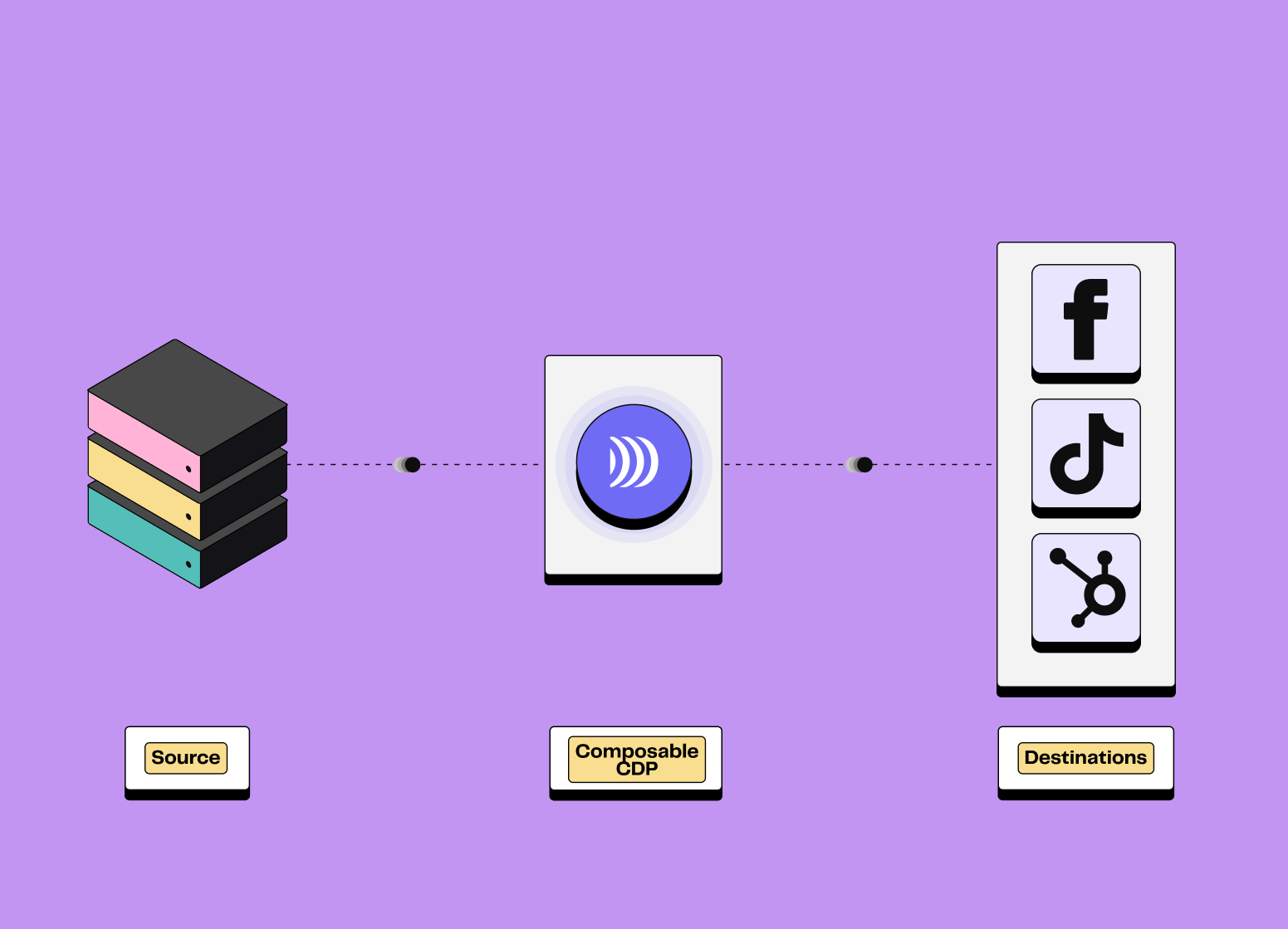
Download our Comparison Guide
All differences between Traditional and Composable CDPs
9 Key Benefits of Modular CDPs
Modular Customer Data Platforms, or composable CDPs, offer several benefits to businesses that make them a valuable investment. Here are 8 key benefits to consider:
Flexibility: A modular CDP is designed to be customised easily, so you can create a CDP that is tailored specifically to your business needs.
Scalability: With a microservices architecture, a modular CDP can be scaled up or down based on your requirements, making it highly adaptable.
Integration: Modular CDPs can be easily integrated with other marketing technologies, such as CRM, DMP, and Marketing Automation platforms, making them highly compatible.
💡Consult our resource to understand all the use cases covered by a CDP.
Cost-effectiveness: A modular CDP eliminates the need for multiple CDPs for each use case, making it a more cost-effective solution. Plus, it allows businesses to create a custom platform that meets their specific needs without incurring unnecessary expenses.
Better Data Governance: A Composable CDP offers complete transparency, assurance, and auditability throughout the entire customer data architecture process. By controlling what information is collected, stored, and shared with your marketing partners, you can ensure compliance with data regulations such as GDPR and CCPA.
Improved Data Quality: By managing and standardising customer data into a single source of truth, the data warehouse, businesses can improve the quality of their data.
Faster Time-to-Value: No need for SQL or coding, you can achieve faster time-to-value by quickly launching new campaigns and initiatives on fresh audiences with a modular CDP.
Enhanced Customer Experience: Thanks to the single source of truth, modular CDPs cut off with data silos and enable businesses to create a unified view of the customer and deliver personalised experiences across all channels, leading to enhanced customer experiences and increased customer loyalty.
Better Marketing ROI: Combining marketing creativity with reliable data is the perfect recipe for delivering personalised experiences that resonate with your customers and optimise marketing spend. A modular CDP is a valuable investment if you are looking to enhance your marketing capabilities and improve your bottom line
Conclusion
In conclusion, traditional CDPs are no longer sufficient for modern marketing. The rise of cloud data warehouses and modular CDPs has made it possible for you to achieve a single source of truth in data, and to realise the dream of a 360° view of your customers. This has led to more efficient and effective decision-making, as well as a more harmonious working relationship between data teams and marketing teams.
By seamlessly integrating all Martech tools and accessing valuable data across the entire marketing stack, the Composable CDP has become a powerful tool for optimising marketing efforts and achieving better results in today's data-driven world.
Get connected to our experts at DinMo, the Data-Led Growth platform and learn how to transform your data warehouse into a modular CDP and take full advantage of your data to drive growth.
FAQ
What are the benefits of a modular CDP for marketing teams?
What are the benefits of a modular CDP for marketing teams?
A modular CDP gives marketing teams easy access to reliable, up-to-date, and unified data. They can build dynamic segments, launch personalised campaigns independently, and measure impact in real time.
The advantages: greater agility, relevance, and a higher return on investment.
How does a modular CDP differ from a traditional CDP?
How does a modular CDP differ from a traditional CDP?
A modular CDP builds on the company’s existing data infrastructure, particularly the cloud data warehouse, to organise, unify, and activate customer data without duplication.
Unlike traditional CDPs, it is more flexible, scalable, and interoperable with the modern marketing ecosystem. Thanks to its zero-copy architecture, it also enhances data governance and security.















